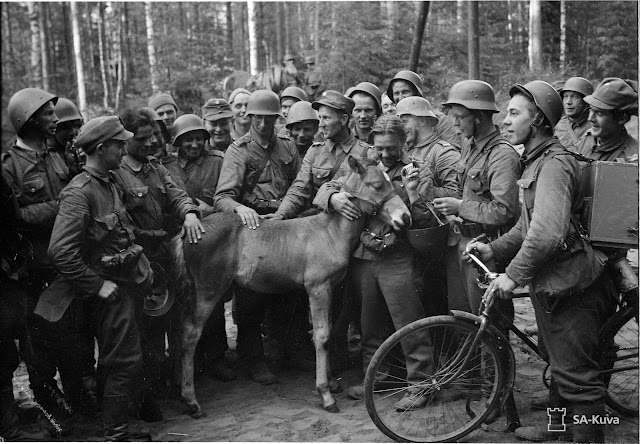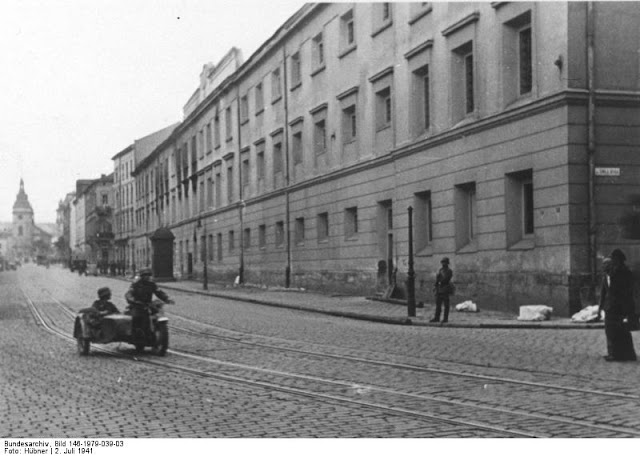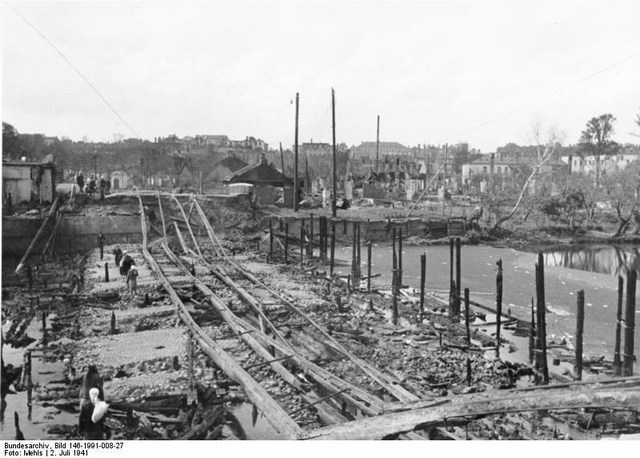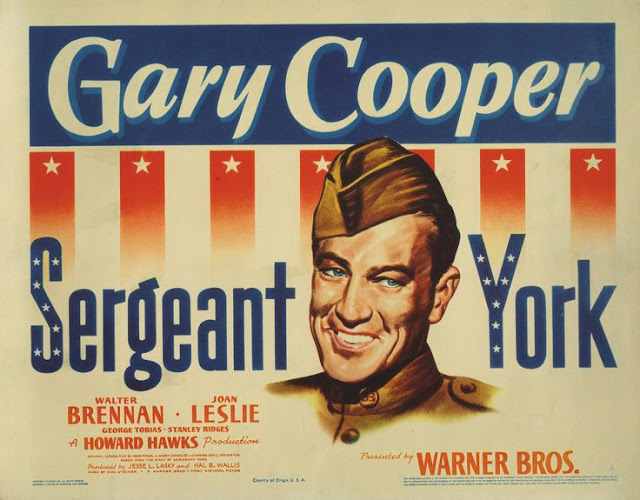Tuesday 22 July 1941
 |
| A Finnish soldier wounded by grenade shrapnel at Kaalamo in Sortavala district, just north of Lake Ladoga, 22 July 1941. |
Field Marshal Fedor von Bock, who would lead the advance on Moscow as commander of Army Group Center, notes in his war diary (Tagebuchnotizen Osten I) the following:
Brauchitsch (Wehrmacht commander) called and said the Fuhrer has ordered that all further advance of the armor to the east is no longer a matter of discussion.One might think that this would settle the issue of an advance on Moscow once and for all. But, it does not, as German generals exhibit a surprising degree of independence (some might call it subversion) against the wishes of the Fuhrer. Note that many histories claim that the Germans had to stop for supply reasons or so forth - but they didn't. This was a Hitler order.
All that said, this may be the high point of the German advance into the Soviet Union in terms of matching reality to the objectives. The Wehrmacht has occupied some 700,000 square miles of Soviet territory and has large Soviet formations close to collapse at Kyiv. The German panzer spearheads are intact (if worn down), but the Soviets always seem to have more troops to feed into the grinder. A critical phase of the offensive is at hand because it is vital for the Germans to destroy the Red Army before the weather turns, and the pace of the advance must be sustained to accomplish that.
In the Far North sector, Finnish VI Corps advances 23 km southeast past Salmi along the eastern shore of Lake Ladoga to take the tiny village of Manssila. The Soviet defense is hampered by the troops' unfamiliarity with the area, its remoteness, and extreme German pressure on the main front. The Finns now are approaching the 1939 border, and Marshal Mannerheim, the Finnish commander, has a decision to make as to whether to invade pre-war Russia or settle for his purported war aims of simply recovering territory on which Finland has a historical claim. Nobody knows what Mannerheim's decision will be, but he only has another day or two to make it. Meanwhile, Finnish VII Corps on the western shore of Lake Ladoga finally has cleared a pocket of Soviet troops along the Jänisjoki River and can continue toward Leningrad. Further north, at Salla and on the Litsa River, the German/Finnish advances are completely stalled.
In the Army Group North sector, German Panzer Group 4 reaches Lake Ilmen to the south of Leningrad. The panzers stop here to do maintenance and wait for the infantry to close up with their advanced position.
In the Army Group Center sector, the Germans continue to subdue the Mogilev and Smolensk pockets. General Hoth's Panzer Group 3 recovers its units that have been assisting with the encirclement and prepares for further action to the east. The panzer spearhead at Yelnya consolidated its bridgehead.
In the Army Group South sector, Field Marshal Rundstedt's armies continue making progress toward encircling the large Soviet forces at Uman.
 |
| German medics assist a gravely wounded Red Army soldier. This photo was taken in July 1941, early on in the war with Russia, when Soviet prisoners are still treated. |
In a sign of a situation that is becoming a problem for the Wehrmacht, Major General W. Nehring's 18th Panzer Division receives 30 new Panzer Mark III's and IV's. Despite this reinforcement, the division now is only at 20 percent of its authorized strength. This is becoming the norm for German panzer divisions.
Reinhard Heydrich, who apparently does not have enough to do as the chief of the Reich Main Security Office and boss of the Gestapo, likes to dabble in flying Luftwaffe combat missions - perhaps to justify on the battlefield his Iron Cross First Class and Frontflugspange (Front Pilot Badge) in silver. Heydrich is not a particularly good pilot (he began the war as an occasional turret gunner and, after training as a pilot, crashed on take-off on 31 May 1940, injuring himself). However, Heydrich has the clout to fly with front-line squadrons such as JG 27 anyway. Today, over Yamil, his Bf 109 is hit by Soviet anti-aircraft fire. Heydrich manages to barely make it back to German lines, evading a Soviet patrol, but this is his last such mission. Hitler forbids Heydrich from flying in combat any more because his capture would be a devastating security breach and propaganda victory for the Allies - and likely very bad for Heydrich's health. It is not known how many combat missions Heydrich has flown altogether, but according to Ballantine Books' Illustrated History of the Violent Century (1973), Heydrich flew 97 missions in a Bf-110 twin-engine fighter. He likely flew many more missions, but how many is unknown.
 |
| Universal carriers and motorcycles of 4th Battalion, The Welch Regiment, on maneuvers at Keady in County Antrim, Northern Ireland, 22 July 1941 (© IWM (H 11968)). |
After dark, RAF Bomber Command sends 63 bombers (34 Hampdens, 16 Whitleys, and 13 Wellingtons) against Frankfurt. All planes return safely.
RAF Bomber Command also sends 29 Wellingtons to Mannheim without loss. Smaller raids are made by 19 Wellingtons and Whitleys to Dunkirk, and 5 Hampdens to do minelaying off Brest. There are no losses with these missions, either.
According to Italian Foreign Minister Count Galeazzo Ciano's diary, Italian leader Benito Mussolini has ordered the Regia Aeronautica to conduct mock air raids on Rome, one for every real raid on Naples, to "keep people sharp" and remind them that there's a war on. One takes place today, and the public reaction to such "practice" - which includes live anti-aircraft fire against Italian planes - is decidedly negative.
Having had a wild adventure in occupied Europe since the fall of France, including crossing occupied Europe and being arrested by the Spanish, then escaping, Dutch fighter pilot Colonel Remy Van Lierde arrives in England. He is interrogated by MI5 at the London Reception Centre and cleared for duty with the RAF.
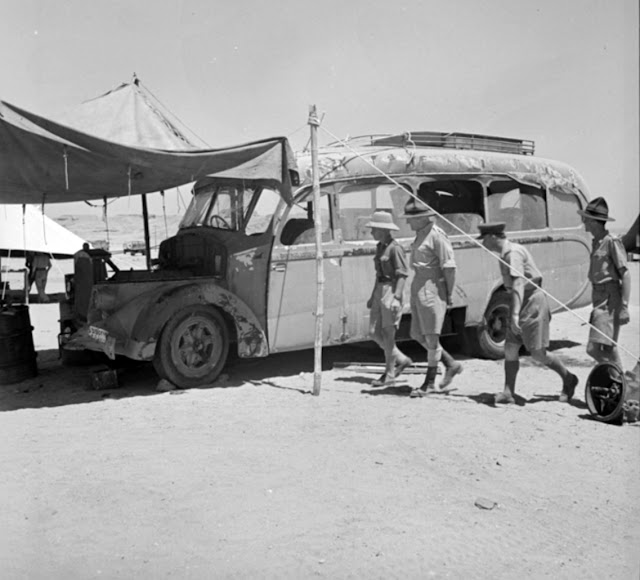 |
| Italian vehicle captured by NZ Infantry, 22 July 1941 (Ardboe Heritage). |
The Soviet crew of destroyer Serdity, bombed by Junkers Ju 88 aircraft of KGr 806 on the 18th, finally gives up efforts to save the ship. They scuttle the ship in Moon Sound.
U-140 (Kptlt. Hans-Jürgen Hellriegel), a training boat attempting to follow up on its unexpected sinking of Soviet submarine M-94 on the 21st, attacks Soviet submarine M-98 at the entrance to the Gulf of Finland. However, the attack fails, and M-98 picks up three survivors of M-94.
The Royal Navy also responds to the German redeployment of Scharnhorst, and its response just after noontime shows how hair-trigger sensitive Whitehall is to the Kriegsmarine's capital ships. The Admiralty brings battleship HMS King George V, aircraft carrier Victorious, heavy cruisers Devonshire, Shropshire, and Suffolk, light cruisers Aurora and Nigeria, and destroyers Achates, Active, Antelope, Anthony, Escapade, Icarus, Intrepid, Punjabi and Tartar to one hour's readiness. All this is done for a routine passage of one German ship between ports. The majority of the ships remain on high alert for 24 hours, until the Scharnhorst is spotted by the RAF at La Pallice at 12:26 on the 23rd.
In the far North, four German destroyers (Friedrich Eckholdt, Hermann Schoemann, Karl Galster, and Richard Beitzen) conduct a patrol east of Murmansk along the Kola coast. They sink Soviet survey ship Meridian between Iokanga and Teriberka in Murmansk Oblast. This is a route used by ships heading to Archangel (Arkhangelsk). The Red Air Force attacks the German ships, but they make it back to port.
The last lifeboat from Royal Navy armed boarding vessel HMS Malvernian, bombed on 2 July, makes it to Vigo carrying 32 survivors, including the captain.
Royal Navy minelayer HMS Teviotbank, escorted by survey ship Scott, lays minefield SN-21B in the North Sea.
The German 4th S-Boat Flotilla (Kptlt. Batge) lays 18 mines southeast of Isle of Wight.
Convoy HX-140 departs from Halifax bound for Liverpool, Convoy SC-38 departs from Sydney, Nova Scotia bound for Liverpool, Convoy WN-56 departs from Pentland Firth bound for Scapa Flow.
Royal Navy destroyer HMS Cowdray, corvette Fritillary, and minesweeper Ardrossan are launched.
Canadian corvette HMCS Brandon (Lt. John C. Littler) is commissioned.
US destroyer USS Harding (DD-625), not named after the former President but rather a Revolutionary War naval officer, Seth Harding, is laid down.
U-117 and U-171 are launched, U-450 is laid down.
 |
| "Marmon-Herrington armoured cars in the streets of Aleppo, 22 July 1941." © IWM (E 4409). |
Royal Navy submarine HMS Tetrarch uses its deck gun to bombard the port of Karlovassi on the Greek island of Samos. The submarine claims to damage a number of caiques in the harbor, which are used by the Germans for communications between islands.
Royal Navy submarine HMS Urge attacks a small convoy off Palermo but makes no hits.
Swordfish torpedo bombers of RAF No. 830 (based on Malta) Squadron sink 8230-ton German transport Preussen about 30 miles southeast of the Italian fortified island of Pantelleria. There are 190 deaths. The Preussen is part of a Naples/Tripoli convoy.
British Blenheim bombers (or Swordfish of RAF No. 830 Squadron, the sources differ) bomb and damage 6996-ton Italian tanker Brarena about 80 miles south of Pantelleria. The ship is set ablaze and attempts to tow the Brarena fail. It ultimately sinks.
Greek submarine Glaukos, operating just off Castelorizzo (Kastellorizo) just off the coast of Turkey, sinks a caique carrying artillery.
The Luftwaffe attacks Tobruk harbor after dark and damages Royal Navy destroyer HMS Hero. She makes it to Mersa Matruh for repairs.
The Luftwaffe also attacks the Suez Canal during the night.
At Malta, the RAF Inspector General, Air Chief Marshal Sir Edgar Ludlow-Hewitt, and staff complete their stopover and proceed to the Middle East.
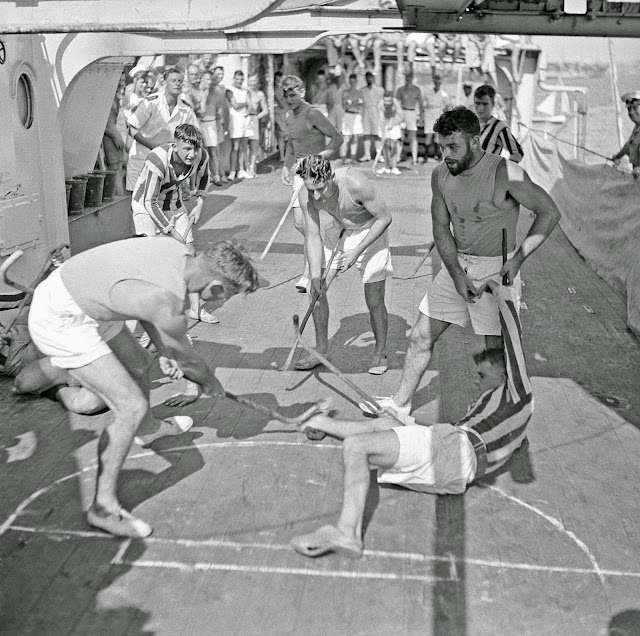 |
| Crew members of HMS Leander playing deck hockey while the ship is berthed in Alexandria, Egypt, 22 July 1941. |
Royal Navy troop convoy WS-9AX (Winston Special) arrives in Bombay en route to Colombo and Singapore.
Battle of the Pacific: The last of eight Japanese cargo ships that have been transiting the Panama Canal, one per day since 16 July, makes the trip. The Japanese have been fearful that the US might search and/or seize the ships, but in fact, the danger was different than they expected. The ship makes it through just in time - the US authorities temporarily close the canal for "maintenance work" after it is safely in the Pacific.
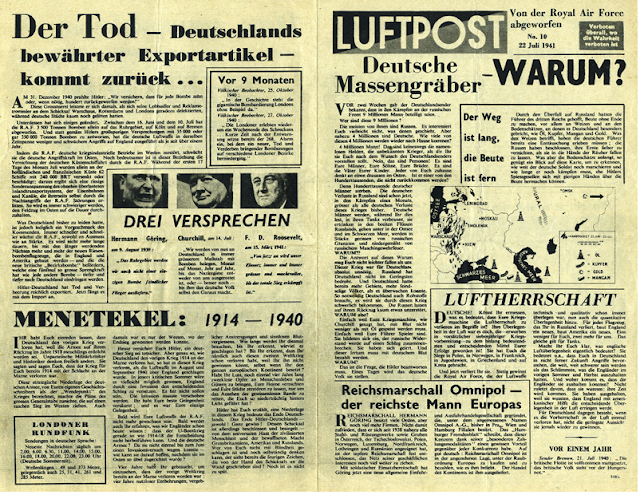 |
| German propaganda, Luftpost No. 10, 22 July 1941. |
On Sunday night through to Monday morning, the German Luftwaffe launched its first grand assault on the Soviet capital. A responsible authority in Berlin confirms that large numbers of bombers wings mounted an extremely vigorous attack. The raids continued for several hours without let-up, we believe from sunset until dawn. The German aerial attack on Moscow confirms that the German Luftwaffe has now been successful in setting up takeoff bases inside the conquered Russian territories. These bases are well situated for its bomber missions so that the bombers are now only a few hundred miles from Moscow and can make intensified attacks on the Soviet capital.The News Bureau statement is factually correct as far as it goes. However, as with the raids on London from September 1940 to May 1941, the actual impact of such raids is highly questionable. While it may be true that the raid was "extremely vigorous," in fact it did not cause much damage of importance to the war effort and was largely frustrated by fierce Soviet anti-aircraft fire.
The German military high command (OKW) issues a triumphant communique:
The breakthrough operations of the German Wehrmacht and its allies have broken the Soviet defensive front into disconnected groups. Despite tenacious local resistance and dogged counter-attacks, any unified conduct by the enemy is no longer discernible. Operations to smash and annihilate the individual Soviet armed forces groups are continuing without let-up along the entire Eastern Front. Last night the Luftwaffe attacked Moscow for the first time in retaliation for the Bolshevik air raids on the open capital cities of our allies, Bucharest and Helsinki. Strong German bomber formations with good ground visibility made relay bombing raids on military installations in the Soviet Russian communications and munitions center in Moscow. Direct bomb hits started countless conflagrations and wide-spreading fires in the Kremlin district and around the Moskva river bend. High ranking Soviet headquarters buildings and government offices have been destroyed or badly hit, as have supply factories.As usual with Berlin announcements, the reality is somewhat less dramatic than the OKW communique would suggest. The Soviet forces have been retreating, but now in some areas have reached defensible lines. The Red Army remains intact despite its savage beating in the first month of the campaign, and there is plenty of evidence of "unified conduct." As for the Nietzschean rhetoric about the effects of the Moscow air raid, the Soviet government buildings were barely touched - perhaps because they were not the targets in the first place. Instead, railways, airfields, and major factories were the targets, and those did receive moderate damage.
The Soviet Information Bureau has a somewhat different take on the matter:
Yesterday evening Moscow experienced its first air attack of the war. The sirens sounded at 10:00 P.M. after lookout men had reported more than 200 German bombers flying toward Moscow. Soviet night interceptor planes and antiaircraft batteries went into action and succeeded in forcing the bulk of the attackers to turn back before reaching the capital. Only isolated German-Fascist aircraft succeeded in breaking through and released a number of bombs that destroyed dwellings or set them on fire, but no military targets were hit. There were several dead and injured. Night interceptors and anti-aircraft guns destroyed 17 German aircraft.While the Soviet news communique is somewhat closer to the truth than the German news bulletins, it also distorts the raid's reality. There were far fewer than 200 Luftwaffe planes (apparently 127), and virtually all of them did attack Moscow. Soviet night fighters barely had any effect, and the Luftwaffe records reported only losing four planes. So, each side is engaging in hyperbole to make the situation look better than it is - as one would expect.
 |
| German propaganda, Luftpost No. 10, 22 July 1941. |
German/Italian Relations: Hitler sends Mussolini an armored train equipped with the latest anti-aircraft guns as a birthday present.
German/Arab Relations: Deposed Iraqi leader Rashid Ali arrives in Germany after a roundabout escape via Afghanistan.
Japanese/Mexican Relations: The Japanese Foreign Ministry puts a stop to secret attempts to negotiate trade deals with Mexico that evade the US/Mexican prohibition against trade with Japan. Thus, they decide to terminate a deal already negotiated which would have sent 7000 boxes of rayon to Mexico in exchange for Mexican goods. The reason apparently is that the Japanese are fearful that they will wind up shipping the rayon, but not get anything in return, and they would have no legal recourse since it is an illegal transaction.
 |
| Slovakian soldiers ponder a staff car destroyed by artillery fire from the Soviet 44th Mountain Rifle Division outside Lipovec, Ukraine (east of Vinnytsia), 22 July 1941. |
The commander of the 4th Army, Major General A. A. Korobkov also is shot today. Many other Western Front generals are shot in the days to come, including the Chief of Staff, Major General B. E. Klimovskikh; the chief of the communications corps, Major General AT Grigoriev; the Chief of Artillery, Lieutenant General of Artillery A. Klich; and Air Force Deputy Chief of the Western Front (who, after the suicide of Major General Aviation I. I. Kopets, was, nominally at least, Chief of the Air Force of the Western Front), and Major General Aviation A. I. Tayursky. The commander of the 14th Mechanized Corps, Major General Stepan Oborin, is under arrest and will be shot on 16 October 1941.
Stalin does not tolerate failure. Is he a hero or a monster? Well, that all depends... did he win or lose in the end?
Dutch Military: While Holland is occupied by the Germans, the Dutch East Indies remain undisturbed. The military remains strong there. Today, it begins conscription throughout the territory.
 |
| Marga Himmler, a Gruppenführer der Waffen-SS, and Frieda Hofmann at Dachau, 22 July 1941 (Federal Archive, N 1126 Bild-16-001). |
The Englishman is superior to the German in one respect - that of pride. Only the man who knows how to give orders has pride.To Hitler, this is a high compliment. Later, he goes a bit further about his attitude toward the British:
For the English, the ideal existence was represented in the society of the Victorian age. At that time England had at her Service the countless millions of her colonial Empire, together with her own thirty-five million inhabitants. On top of that, a million bourgeois — and, to crown the lot, thousands of gentlefolk who, without trouble to themselves, reaped the fruit of other
people's toil. For this ruling caste, Germany's appearance on the scene was a disaster. As soon as we started our economic ascent, England's doom was sealed. It is quite certain that in future England's Empire won't be able to exist without the support of Germany.
I believe that the end of this war will mark the beginning of a durable friendship with England. But first, we must give her the K.O. [knockout] — for only so can we live at peace with her, and the Englishman can only respect someone who has first knocked him out.Unfiltered statements such as this appear to confirm that Hitler has very mixed feelings about the British, which may inform some of his military/diplomatic decisions. Hitler adds further that he's "met a lot of Englishmen and Englishwomen whom I respect." He does not, however, like those with whom he has had "deceptive dealings."
Back in the Reich, Alfred Rosenberg, five days after being appointed as Reich Minister for the Occupied Eastern Territories, Alfred Rosenberg films an address for the weekly propaganda newsreel (Wochenschau). He states that he sees the purpose of his appointment as being to secure "the welfare and public order for the peoples of the East coming under German administration." It is debatable whether Rosenberg at this time knows his true role in the East - to ruthlessly exploit the people and resources there to the sole benefit of the Reich. However, with that statement, Rosenberg is simply parroting the exact language of the 17 July 1941 decree appointing him.
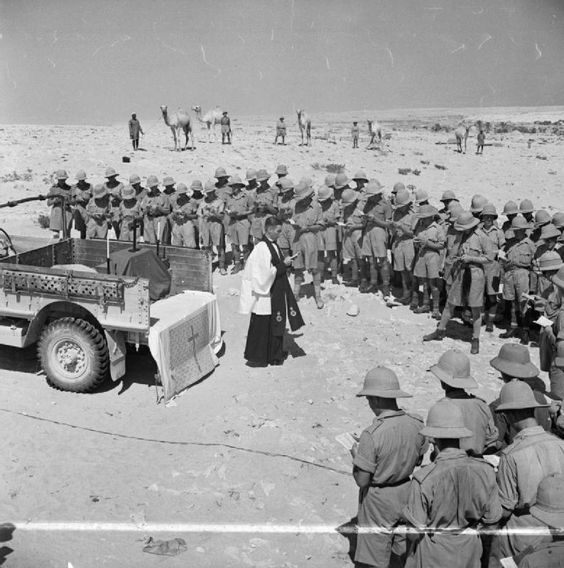 |
| An army truck serving as an altar during a church parade in the Western Desert, 22 July 1941. |
Included in the reform is a new 30-member National Defence Council that will coordinate defense efforts throughout India - efforts which heretofore have been hampered by several different layers of government, including vestigial princely states. However, the internal politicking continues, and Muhammad Ali Jinnah, leader of the All-India Muslim League, is upset that the composition, though primarily Indian, is not 50% Muslim as he has demanded. He also is upset that he has not been the one to choose the Muslim members. Accordingly, he orders all of his AIML followers to boycott the Viceroy's Executive Council and National Defence Council.
 |
| Heinrich Himmler's family (wife Margarete, daughter Gudrun) during a visit to Dachau Concentration Camp, 22 July 1941. They are in the herb garden there. Gudrun, age 11 and apparently pictured on the left noted in her diary that "Today we drove to Dachau. It was beautiful." Also shown in the picture are playwright Hanns Johst, Johst's daughter, Lydia Boden, Hanne Johst, Frieda Hoffmann, and some unidentified people. (Photo: Piper Verlag) (Federal Archive, Bild N 1126 Bild-16-002). Incidentally, Gudrun Himmler, later Gudrun Burwitz, became active with the Stille Hilfe, an organization that aids former SS members, and passed away in June 2018. It was revealed at that time that she was a secret agent for the West German government from 1960-63. |
Anne Frank is captured on film for the only time incidental to the wedding of the girl next door.
Heinrich Himmler brings his family to Dachau for the day. His wife Margarete and daughter Gudrun spend the day walking through the gardens and enjoying a guided tour. Gudrun notes in her diary:
Today, we went to Dachau. We saw everything we could. We saw the gardening work. We saw the pear trees. We saw all the pictures painted by the prisoners. Marvelous. And afterward, we had a lot to eat. It was very nice.Pictures show them in their "Sunday best" walking in areas bereft of prisoners.
Japanese Homefront: After two weeks of heavy rain, 12,000 homes in Tokyo are flooded.
 |
| Chief Engineer George E. Johnson is shown above speaking at the dedication ceremony of the Kingsley Dam, 22 July 1941 (Courtesy Central Nebraska Public Power and Irrigation District). |
 |
| Two unidentified young ladies drop a time capsule into the Kingsley Dam, 22 July 1941. |
 |
| A crowd at the dedication of the Kingsley Dam, 22 July 1941. |
Future History: George Edward Clinton is born in Kannapolis, North Carolina. He develops an unusual form of funk music in the 1970s with his two groups Parliament and Funkadelic that leads to a solo career in 1981. He is inducted into the Rock and Roll Hall of Fame in 1997 along with members of his groups. As of this writing, George Clinton continues to perform with his group "Parliament Funkadelic."
Vaughn Bodē is born in Utica, New York. He becomes a top underground cartoonist and illustrator perhaps best known as the creator of the character Cheech Wizard. His first self-published book, in 1963 at age 21, is "Das Kämpf." Vaughn Bodē passes away on 18 July 1975.
Ronald Joseph Morel Turcotte is born in Drummond, New Brunswick Canada. He goes on to become a top jockey. Turcotte is best known for riding Secretariat to the Triple Crown in 1973. In 2015, a statue of Secretariat and Turcotte crossing the finish line at the Belmont Stakes is unveiled in Grand Falls, New Brunswick, the hometown of Turcotte. As of this writing in 2018, Ron Turcotte is still active as an advocate for the disabled.
Susie Maxwell is born in Pasadena, California. Mostly under her married name of Susie Berning she goes on to become a top professional golfer, winning four major championships and eleven LPGA Tour victories in all. Since retiring from tour play in 1996, Berning has become a well-respected teaching professional spending time at the Nicholas-Flick Golf Academy. She divides her time between The Reserve Club in Palm Springs, California and Maroon Creek Country Club in Aspen, Colorado.
 |
| July 22, 1941 night photograph from Norfolk Public Library's Sargeant Memorial Collection featuring The NorVA on Granby Street in Norfolk, VA. Other businesses identified include Loew's State Theatre, Bamboo Inn Restaurant, and Wilson Shoes. |
July 1941
July 1, 1941: US TV Broadcasting Starts
July 2, 1941: MAUD Report
July 3, 1941: Stalin Speaks
July 4, 1941: Pogroms in Eastern Europe
July 5, 1941: Germans on Schedule
July 6, 1941: Australians Attack Damour
July 7, 1941: US Marines in Iceland
July 8, 1941: Flying Fortresses In Action
July 9, 1941: British Take Damour
July 10, 1941: Sword and Scabbard Order
July 11, 1941: Cease-fire in Syria and Lebanon
July 12, 1941: Anglo/Russian Assistance Pact
July 13, 1941: Uprising in Montenegro
July 14, 1941: Katyusha Rocket Launchers in Action
July 15, 1941: Smolensk Falls
July 16, 1941: Stalin's Son Captured
July 17, 1941: Heydrich Orders Mass Executions
July 18, 1941: Twin Pimples Raid
July 19, 1941: V for Victory
July 20, 1941: The Man Who Wouldn't Shoot
July 21, 1941: Moscow in Flames
July 22, 1941: Soviet Generals Executed
July 23, 1941: Secret Plan JB 355
July 24, 1941: Operation Sunrise
July 25, 1941: US Naval Alert
July 26, 1941: Italian E-Boat Attack on Malta
July 27, 1941: MacArthur Returns
July 28, 1941: Auschwitz Exterminations
July 29, 1941: Rescue From Crete
July 30, 1941: Raid on Petsamo and Kirkenes
July 31, 1941: Final Solution Order
2020



